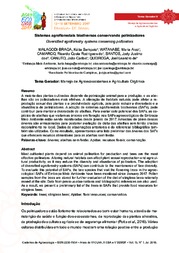Sistemas agroflorestais biodiversos conservando polinizadores.
Sistemas agroflorestais biodiversos conservando polinizadores.
Author(s): MALAGODI-BRAGA, K. S.; WATANABE, M. A.; CAMARGO, R. C. R. de; SANTOS, J. J. dos; CANUTO, J. C.; QUEIROGA, J. L. de
Summary: Resumo: A maioria das plantas cultivadas depende da polinização animal para a produção, e as abelhas são os polinizadores mais efetivos. A alteração de habitats naturais pode afetar a reprodução sexual das plantas e a produtividade agrícola, pois pode reduzir a diversidade e a abundância de polinizadores. A adoção de sistemas agroflorestais biodiversos (SAFs), pode contribuir para manter a diversidade de abelhas. Para avaliar este potencial dos SAFs, as espécies de abelhas que visitam as árvores em floração nos SAFs agroecológicos da Embrapa Meio Ambiente estão sendo monitoradas desde janeiro de 2017. Amostras de pólen dessas árvores são armazenadas para posterior avaliação da dieta das abelhas sem ferrão criadas racionalmente no local. Dados de observações anteriores e do referencial bibliográfico também são utilizados. Como resultado, apresentamos uma lista preliminar das árvores dos SAFs que oferecem recursos alimentares para as abelhas sem ferrão. Abstract: Most cultivated plants depend on animal pollination for production and bees are the most effective pollinators. Altering natural habitats can affect plant sexual reproduction and agricultural productivity, as it may reduce the diversity and abundance of pollinators. The adoption of diversified agroforestry systems (SAFs) can contribute to the maintenance of bee diversity. To evaluate this potential of SAFs, the bee species that visit the flowering trees in the agroecological SAFs of Embrapa Meio Ambiente have been monitored since January 2017. Pollen samples from the trees are stored for further evaluation of the diet of stingless bees rationally reared at the site. Data from previous observations and bibliographic references are also used. As a result, we present a preliminary list of the trees in SAFs that provide food resources for stingless bees.
Publication year: 2018
Types of publication: Paper in annals and proceedings
Unit: Embrapa Environment
Observation
Some of Embrapa's publications are published as ePub files. To read them, use or download one of the following free software options to your computer or mobile device. Android: Google Play Books; IOS: iBooks; Windows and Linux: Calibre.
Access other publications
Access the Agricultural Research Database (BDPA) to consult Embrapa's full library collection and records.
Visit Embrapa Bookstore to purchase books and other publications sold by Embrapa.

